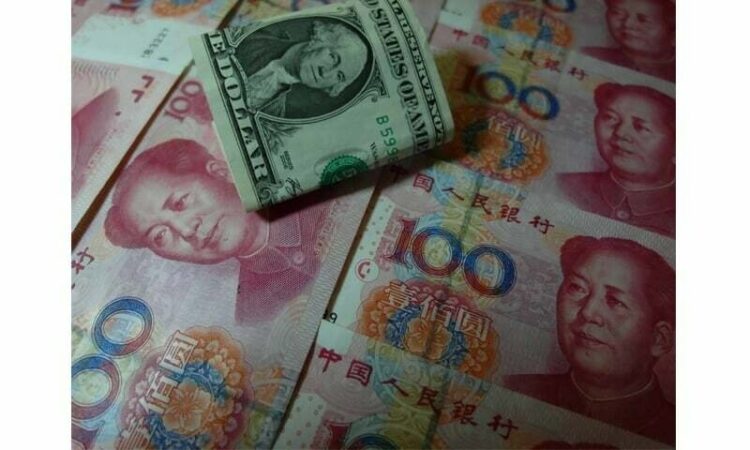
The central banks of Pakistan and China have renewed their commitment to expanding their bilateral trade and investment in the Chinese yuan. For that purpose, they signed a memorandum of understanding on establishing yuan clearing arrangements during a recent visit of Prime Minister Shehbaz Sharif to China.
According to a senior banker, Yuan clearance enables Pakistan to access Chinese banks and make commercial borrowings easier from them.
The financing facility was increased by 10 billion yuan to 40bn yuan or roughly $6bn under the latest currency swap agreement (CSA ) to clear import payments in the current fiscal year.
Pakistan imported goods and services worth $18bn last year, of which imports payments worth $4.5bn were paid in Chinese yuan. In FY21, Islamabad made over Rs26bn in interest payments to China by utilising 30bn yuan ($4.5bn). Last year, we exported goods and services worth $2bn to China.
China, Japan and India are reported to have started selling US Treasuries in recent weeks to help support their currencies
The currency swap agreement is aimed at reducing the country’s reliance on dollar-based payments settlement, helping stabilise foreign exchange reserves and supporting the rupee against the greenback. There is, however, no immediate impact on the value of the rupee versus the dollar in the exchange markets.
Finance Minister Ishaq Dar and State Bank of Pakistan Governor Jameel Ahmad, agreed in their meeting on November 7 that the government’s administrative efforts and the regulatory/policy measures taken by the SBP have resulted in the rupee’s stability and restrained exchange rate instability.
Further steps are underway to discipline the wayward segment of the currency market as the target of reducing rupee-dollar parity to below Rs200 — set by Mr Dar and agreed upon by the SBP governor — has yet to be achieved. The rupee was quoted at Rs221.65 against the greenback on November 8, according to SBP data.
The SBP and the Federal Investigation Agency have decided to take joint action against illegal exchange operators to curb speculation and the grey market and stop the ‘smuggling’ of foreign currency through Peshawar. It is likely to bridge the gap between interbank and kerb markets.
According to a media report, the SBP and the government had earlier decided to cut by half the foreign exchange purchases per person to $5,000 and capped the outward annual remittance limit at $50,000.
Pakistan is not alone in trying to defend the value of its national currency against the dollar, while the greenback is gaining strength owing to US Federal Reserve’s rapid and sizeable increases in interest rates.
Sharp US interest rate hikes to curb the high rate of inflation are starting to disturb the financial system so much that some US analysts warn that it could snowball into a bout of serious instability. This expectation has led many central banks of both developed and developing countries to take steps to bolster the value of their domestic currencies by buying their own currencies.
Most countries, such as Japan, India, South Korea, Taiwan, the Philippines, Vietnam, Malaysia and Thailand, have resorted to currency interventions. They have managed to reduce the pace but not halt the slide of their currencies. To quote an analyst, their efforts highlight both the interconnected nature of the financial system and its vulnerabilities.
China, Japan and India are reported to have started selling US Treasuries in recent weeks to help support their currencies. As foreign reserves balances run lower, analysts say there is a risk that countries will begin to sell US Treasuries more aggressively.
The reserves — held in major currencies such as dollars, British pounds and euros — have declined because most currencies have weakened against the greenback. Analysts note that a weaker currency means it costs more for a country to import food, energy and other goods.
Meanwhile, Washington Post has reported that the US is privately urging Ukraine to signal its openness to negotiate with Russia. The Ukrainian president’s refusal to talk has generated concern in parts of Europe, Africa and Latin America, where war effects on food and fuel costs are felt most sharply. “Ukraine war fatigue is real for some of our partners,” the newspaper quoted US officials as saying.
Britain’s crisis is the first recent case where an advanced economy with its own currency arguably ran into trouble in raising both financing it needed and the external financing it needed, says Brad Setser, an expert on global trade and capital flows.
Britain’s net government borrowing this year will be about 4.3pc of its GDP, just a little more than the corresponding figure of 4pc for the United States, according to the International Monetary Fund’s World Outlook estimate. And Britain’s current account deficit will be about 4.8pc versus 3.9pc for America.
To quote Peter Coy, a seasoned analyst, the dollar’s strength also creates problems for the US. It makes its exports more expensive and imports cheaper, which worsens the current account deficit.
The US may land in the same mess one day, says Coy, as Britain is currently facing, while quoting other experts that say the current US situation is very different from that of the UK. The dollar is an international currency, and the US enjoys relative political stability.
However, on November 4, the greenback tumbled after the US non-farm payrolls report for October showed that the US unemployment rate in October rose to 3.7pc from 3.5pc in September, and the wage increases slowed down to 4.7pc year-on-year in October from 5pc in September. The US dollar index, a measure of the greenback’s value against six major currencies, fell 1.9pc to 110.77. It is the largest one-day percentage loss since November 2015.
Responding belatedly to the dollar’s depreciation, the Russian rouble on November 7 was 1.5pc stronger against the greenback at 61.19. This is because the Russians are selling oil in their own strengthening currency.
Published in Dawn, The Business and Finance Weekly, November 14th, 2022



